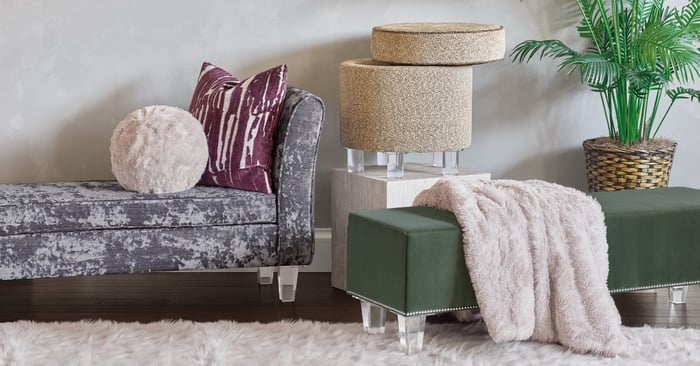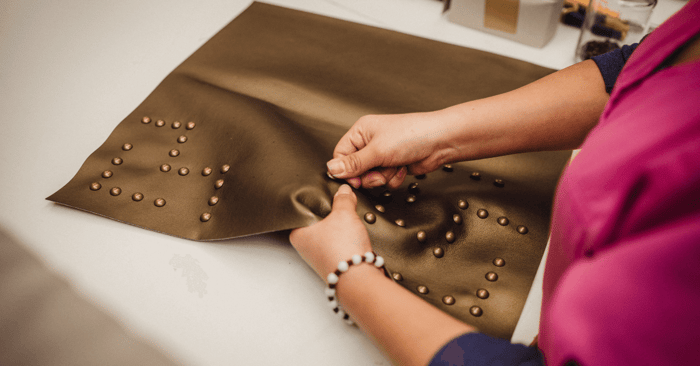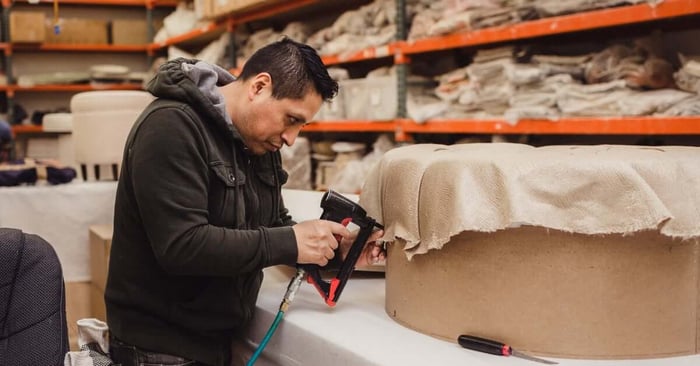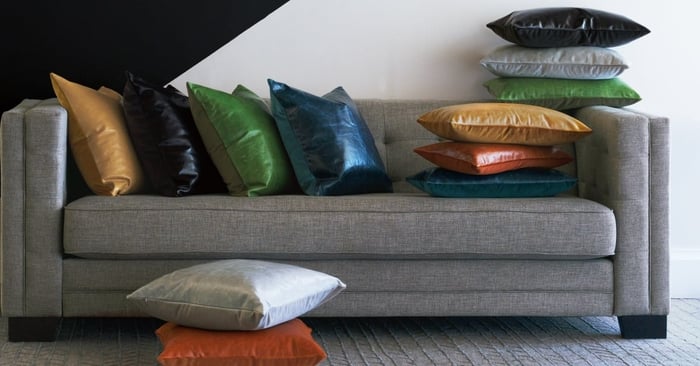Table of Contents
Lucite, a high quality form of acrylic, has a long history in the world of design. Our Chicago-based design team at Eastern Accents loves to pair the modern elegance of acrylic furniture legs with glam bedding collections. Lucite embraces versatility and adds a flair of contemporary style to any interior space.
A Historical Journey: From Fighter Jets to Jewelry
Invented as an alternative to glass, Lucite gained popularity first in the manufacturing and production of fighter jets, cars, airplane windows, and in many other commercial and military uses. Unlike other, cheaper acrylics, it does not yellow, is relatively scratch resistant, and remains highly transparent over time. It is stronger than glass and can be easily molded into different forms.
Although this acrylic material was born out of the Great Depression and was first used by the military, it didn‘t take long for this durable plastic to start making waves in the jewelry industry. It quickly took the place of other plastic resins and was most notably used by the American jewelry company Trifair, which used it to make a line of animal brooches in the 1940s.
 |  |
Popularity in Home Decor: Retro and Futuristic
Trifair’s success quickly encouraged other companies to use this versatile acrylic. By the 1960s, it had made its way into homes. The clear material embraced the trendy futurism of the 1960’s, while still calling back to the practicality of plastic instead of glass.
With the expert help of Brilliant Acrylic Design & Pease Plastic (another Chicago-based manufacturer), we have created high end, durable Lucite furniture legs that are a sophisticated, luxe addition to any upholstered furniture.
 |  |
 |  |
To explore these options, you can build your own furniture on our website, or browse benches and ottomans in collections such as Esmerelda, Talena, Danae, and Valentina.
Maintenance Tips: Preserving the Shine and Durability of Lucite
 | Although Lucite maintains its integrity better than glass or other acrylics, the trials of the home environment are unavoidable. After a couple years you may notice it has lost some of its shine and scratches may appear. Using a microfiber cloth or a soft cotton rag with a plastic polish and cleaner, such as Novus or Sparkle, you can buff out scratches. We recommend avoiding paper towels, since they will cause small scratches. Ammonia-based cleaners should also be avoided because they can discolor the acrylic and cause cracks. |
Always make sure you pick up and move the furniture with two people, rather than sliding it across the floor. Dragging legs across the floor increases the chance of cracking them, weakening the plastic around the screws or breaking the base plate that affixes the legs into the bench or ottoman.
We also offer the ability to swap out your existing ottoman and bench legs for the acrylic option. Unfortunately, our benchmade headboards and beds do not allow for easy leg switching. In some cases, the foot board legs can be removed and swapped but the headboard legs are built into the frame so switching them would require deconstructing the entire headboard. However, we have designed acrylic legs specifically to go with each of our beds/headboards, and swatches of our furniture legs are available for purchase. Please note that our furniture legs are designed to be compatible with Eastern Accents-made furniture, and may not be suitable for use with pieces not made by Eastern Accents.
If you are interested in learning more about our Lucite furniture legs or have any other questions about our upholstery department, visit our online Furniture Workshop or contact our Customer Service team.
FAQs
When was Lucite invented?
Invented as an alternative to glass, Lucite gained popularity first in the manufacturing and production of fighter jets, cars, airplane windows, and in many other commercial and military uses.
Although this acrylic material was born out of the Great Depression and was first used by the military, it didn‘t take long for this durable plastic to start making waves in the jewelry industry. It quickly took the place of other plastic resins and was most notably used by the American jewelry company Trifair, which used it to make a line of animal brooches in the 1940s.
What is Lucite?
Lucite is a high quality form of acrylic, a strong, transparent synthetic material.
What are the benefits of Lucite?
Unlike other, cheaper acrylics, Lucite does not yellow, is relatively scratch resistant, and remains highly transparent over time. It is stronger than glass and can be easily molded into different forms.
How do you care for Lucite?
| Although Lucite maintains its integrity better than glass or other acrylics, it can still lose some of its shine or scratch over time. Using a microfiber cloth or a soft cotton rag with a plastic polish and cleaner, such as Novus or Sparkle, you can buff out scratches. Avoid paper towels, since they will cause small scratches. Ammonia-based cleaners should also be avoided because they can discolor the acrylic and cause cracks. |





